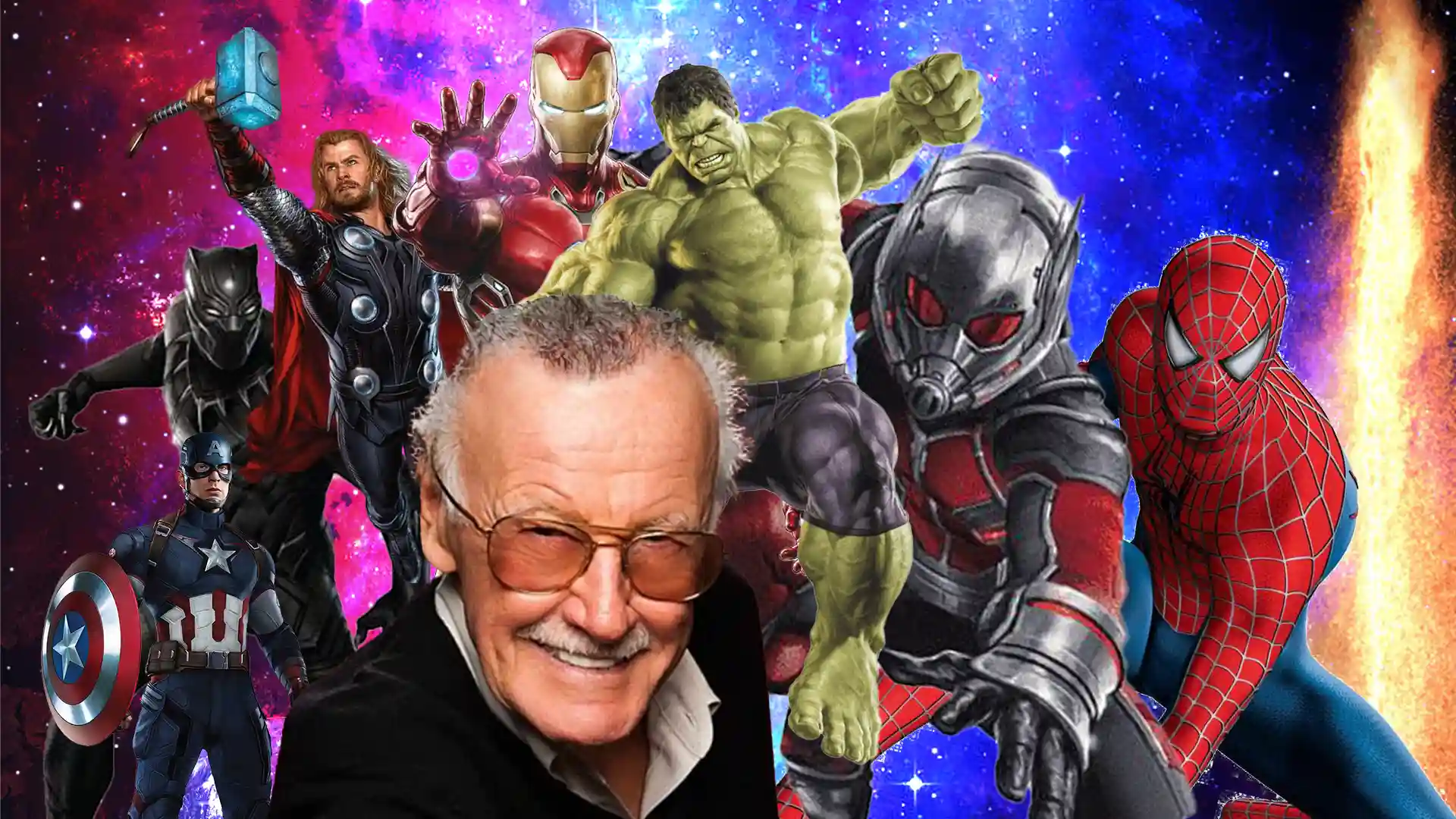Learn about the incredible life of Stan Lee, the man behind some of pop culture’s most recognizable superheroes. Investigate his background, work, and cultural imprint. Find out how Stan Lee’s talent changed comics and other forms of entertainment.
Meet Stan Lee
Stan Lee’s Influence on Pop Culture and Comic Books
Stan Lee made enormous contributions to the comic book business in the 1960s, transforming it with his renowned character creations and creative storytelling methods. But his impact on popular culture went far beyond comic books, as he had a lasting impression on the larger field. The stories and characters he co-created served as the basis for popular film series, Broadway productions, and other entertainment mediums that still have an impact on viewers today.
Stan Lee’s Legacy in Entertainment Media
Stan Lee’s creations, which include Spider-Man and Black Panther, have not only taken over comic book stores but have also been expertly adapted into other media. These characters have taken center stage in some of Hollywood’s most lucrative film series, drawing in billions of dollars in box office revenue and enthralling viewers across the globe. Lee’s characters are also a mainstay of contemporary pop culture since they have helped to push cultural boundaries and tear down barriers.
Marvel’s Blockbuster Franchises

Spider-Man: A Multifaceted Franchise
Originating from Lee’s idea, the Spider-Man franchise has grown into a Broadway musical production as well as a successful film series. The character has struck a chord with viewers of all ages thanks to his humorous antics, superhuman exploits, and genuine hardships. In addition to being a financial triumph, the movies made Spider-Man one of the most adored and famous fictional characters ever.
Iron Man: A Hollywood Gold-Mine Series
Iron Man, which Lee co-created, was given new life on the big screen by Robert Downey Jr.’s captivating performance. In addition to reviving Downey’s career, the Iron Man film series proved to be a huge financial success for Marvel Studios. The character’s unique blend of moral quandaries, technical innovation, and personal development struck a chord with current viewers, which helped to establish the character’s notoriety in the entertainment industry.
Black Panther: Breaking Racial Barriers
Breaking down boundaries between races and establishing new benchmarks for diversity and representation in mainstream media, “Black Panther” became a landmark film. Wakanda was brought to life on screen by Lee’s co-created character T’Challa, who included a cast that was primarily black and showcased African culture. The movie’s critical and financial success proved the value of varied storytelling and strengthened the impact of Spike Lee on contemporary popular culture.
Other Film and TV Juggernauts
Outside of Spider-Man, Iron Man, and Black Panther, the Marvel universe grew. Successfully transferring from comic books to cinema and television, characters such as Thor, the X-Men, and the Hulk captivated viewers with their intricate storylines and fantastical adventures. These adaptations demonstrated Lee’s talent for developing characters with complex personalities and likable flaws that connected with viewers of different media types.
Stan Lee’s Role in Marvel’s Rise
Central Player in Marvel’s Character Creation
It is impossible to overestimate Stan Lee’s significance in the development of Marvel’s characters. Beloved superheroes were born out of his dynamic partnerships with outstanding artists like Steve Ditko and Jack Kirby. Lee was involved in many aspects of the business, from writing and editing tales to managing the artistic direction. He was a major factor in the transformation of Marvel Comics from a niche publication to a sensation in popular culture.
Marvel’s Emergence as an International Media Behemoth
Marvel Comics grew from a tiny publishing house to a multinational media conglomerate under Lee’s direction. Marvel’s characters and stories gained international recognition thanks to his innovative vision and astute commercial sense. Writing, editing, and promoting were just a few of the many diverse skills Lee possessed that helped to define Marvel’s brand and solidify its enduring influence on popular culture.
Stan Lee: Writer, Editor, Publisher, and Promoter
Stan Lee was a multi-talented man who played many different positions at Marvel Comics. He distinguished himself as a writer by giving his characters human traits that set them apart from conventional one-dimensional superheroes. With Lee’s editorial skills, plots were improved and refined to create compelling narratives that readers could relate to. In addition, his tireless promotion helped Marvel amass a devoted following thanks to his memorable catchphrases and endearing demeanor.
Marvel’s Silver Age and Complex Characters
Marvel’s Cultural Significance in the 21st Century
Under Stan Lee’s creative direction, the Marvel silver age established the foundation for the brand’s ongoing cultural prominence. During this time, comic books experienced a surge in popularity, complex character development, and unprecedented acceptance in popular culture. Under Lee’s direction, Marvel’s strategy opened the door for intricate plots, lovable characters, and in-depth examinations of contemporary concerns and trends in society.
Complex Characters with Relatable Flaws
An essential feature of Stan Lee’s narratives was the humanization of superheroes. He was a trailblazer in the development of characters that, despite their enormous talents, had real weaknesses, fears, and self-doubts. This strategy promoted emotional investment and empathy by enabling readers to establish a personal connection with the characters. Thanks to Lee’s determination to make heroes seem like real people, comic books became more relevant in society and the genre was elevated.
Marvel’s Approach to Character Development
Stan Lee changed the comic book industry with his distinctive approach to character development. Readers may relate to characters like Spider-Man, the Fantastic Four, and the Hulk better because they faced real-life difficulties. Lee set the way for the development of more complex heroes and modern storytelling by fusing aspects of humor, reflection, and introspective investigation.
Stan Lee’s Approach to Humanizing Heroes
Creating Multidimensional Characters
Stan Lee infused superheroes with traits that mirrored the complexity of real people in an effort to humanize them. His goal was to portray heroes as insider group, Lee helped the Marvel fan base feel a feeling of solidarity and acceptance. His prose enabled readers to relate to the events and characters in a way that transcended conventional narrative techniques.
Marvel’s Marketing Genius
Marvel’s success was greatly aided by Stan Lee’s marketing skills. His ability to create memorable catchphrases and appealing slogans contributed to the development of Marvel’s brand identity. Words like “Excelsior!” and “Nuff said!” came to be associated with Stan Lee and served to further emphasize the idea that Marvel was a movement rather than just a publisher. Marvel had a cult-like following thanks in part to Lee’s marketing efforts, which also shaped the company’s reputation in the entertainment industry.
Asterisked Asides and Continuity
References to earlier issues and lighthearted asides were hallmarks of Lee’s writing. This approach gave the Marvel universe coherence and gave readers the impression that they were a part of a continuous story. Through his encouragement of readers to dive into the backstories of the characters, Lee improved the immersive nature of Marvel comics.
Stan Lee’s Collaborations and Contributions

Contributions to Character Creation
Stan Lee was frequently chastised for not properly recognizing the creative input of his partners, yet there is no denying that he had a significant hand in the creation of many of Marvel’s most recognizable characters. These characters came to life both narratively and physically because to his cooperation with illustrators like as Steve Ditko and Jack Kirby. These characters became well-known thanks in large part to Lee’s ability to write gripping stories that connected with readers.
Early Life and Career Beginnings
Stan Lee, real name Stanley Martin Lieber, was raised in modest circumstances in Manhattan. His early exposure to movies, pulp magazines, and books influenced his desire to be a creative person. He started off as an office assistant after being hired by Timely Publications, but he soon moved into story writing and editing. Thanks to his unwavering commitment to pursuing his love of narrative, Lee was able to form a pivotal collaboration with artists such as Jack Kirby.
Leadership Amidst Change
Stan Lee became chief editor of Timely Publications when Captain America founders Jack Kirby and Joe Simon left the company. He proved that he could adjust to changing circumstances and successfully negotiate the changing comic book industry. As chief editor, Lee had the opportunity to help Marvel at a critical juncture by directing the company’s course and fostering its expansion.
Prolific Writing Style
Lee’s writing was known for its efficiency and rapidity. He asserted that he could complete nearly all of his writing in one sitting. Because of his prolific productivity, he was able to explore several genres and add variety to Marvel’s roster of titles. Thanks to Lee’s adaptable writing style, Marvel was able to stay vibrant and sensitive to changing reader tastes.
Marvel’s Influence on Cultural Shifts
The Golden Age of Comic Books
The golden age of comic book popularity peaked in the middle of the 1940s. But as the material became more graphic and explicit, questions about morality and juvenile delinquency surfaced. After the industry came under fire, a Senate subcommittee looked into it. During this time, the Comics Code Authority was established as a self-regulatory organization to guarantee clean content, but it also resulted in artistic restrictions.
Marvel’s Response to Changing Landscape
Under Stan Lee’s direction, Marvel struggled to keep readers during the end of the golden age. Lee took inspiration from the popularity of DC’s relaunched Flash and Green Lantern to try and steer clear of clichéd humor and formulaic genre stories. He accepted the task of redesigning superheroes and helped to bring the genre back to life.
Stan Lee’s Creative Reimagining
turning point in Lee’s career was his choice to return to superheroes, which was inspired by DC Comics’ successful relaunch strategy. Rather than merely copying fashion trends, he chose to add complexity, relatability, and cultural significance to his works. Marvel’s silver era and the arrival of characters like the Fantastic Four, who personified human complexity and multifaceted relationships, were made possible by this imaginative reinvention.
Stan Lee’s Favorites and Personal Life
Stan Lee’s Favorite Marvel Character
Stan Lee acknowledged that he had a special affection for Kirby’s Silver Surfer, although he was frequently reluctant to name his favorite of his numerous creations. For Lee, the role was particularly noteworthy since it served as both a vehicle for his own worldview and a philosophical observer. Because of Silver Surfer’s distinct viewpoint, Lee was able to discuss existential subjects and share his opinions on society problems and human nature.
Other Favorite Characters
Stan Lee was also quite attached to other characters he co-created, besides Silver Surfer. With his internal conflict and problems controlling his rage, The Hulk connected with Lee’s examination of human emotions. With his enduring motto of accountability, Spider-Man served as a symbol of Lee’s principles and outlook on life. The individuals and concepts that personally resonated with Lee were represented in his selections.
Stan Lee’s Net Worth and Legacy
Stan Lee’s legacy went beyond his storytelling, as his creative skills elevated him to the status of a cultural hero. His $50 million net worth at the time of his death in 2018 is evidence of his impact on the film business. A National Medal of Arts was bestowed upon him in recognition of his influence on popular culture, highlighting his contribution to the creation of stories that captivated the interest of successive generations.
Conclusion

Stan Lee’s Lasting Influence
Stan Lee made a lasting impression on the entertainment industry with his inventiveness, inventiveness, and captivating charm. Comic books, movies, and other media continue to be a popular medium for his co-created characters. Through her ability to humanize superheroes, delve into intricate topics, and craft empathetic narratives, Stan Lee transformed the comic book industry and catapulted pop culture to new heights.
A Legacy of Timelessness
Stan Lee’s influence on the entertainment industry and the characters he created ensure that his legacy endures even after his death. His work will always be relevant and inspire audiences for many years to come since he was able to tell tales that touched on common themes and feelings.
For more interesting content visit Marvelsurfing.com.



These are genuinely great ideas in on the topic of blogging.
You have touched some fastidious factors here. Any way keep up wrinting.